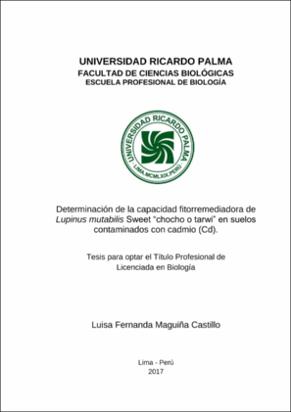Mostrar el registro sencillo del ítem
Determinación de la capacidad fitorremediadora de Lupinus mutabilis Sweet “chocho o tarwi” en suelos contaminados con cadmio (Cd)
| dc.contributor.advisor | Quiñones Aguilar, Mauro | |
| dc.contributor.author | Maguiña Castillo, Luisa Fernanda | |
| dc.date.accessioned | 2017-05-31T16:39:05Z | |
| dc.date.available | 2017-05-31T16:39:05Z | |
| dc.date.issued | 2016 | |
| dc.identifier.uri | https://hdl.handle.net/20.500.14138/910 | |
| dc.description.abstract | Las actividades antropogénicas ocasionan el incremento de metales pesados en los suelos, para mitigar esta contaminación se vienen implementando métodos como la fitorremediación. El objetivo de la investigación fue determinar la capacidad fitorremediadora de Lupinus mutabilis Sweet en suelos contaminados con cadmio. Los ensayos se realizaron en un invernadero bajo condiciones controladas. Las plantas fueron sometidas a cuatro tratamientos: T1 - 4 mg, T2 - 8 mg, T3 - 12 mg, T4 - 16 mg de CdSO4/L respectivamente y un control T0, aplicados en diferentes periodos. El efecto del cadmio a nivel morfológico fue determinado evaluando el daño ocasionado en la raíz, tallos y foliolos. Los cortes histológicos fueron realizados en un micrótomo manual Leica, la tinción desarrollada con hematoxilina-eosina y luego fueron visualizados en un microscopio ocular Leica. La tasa de supervivencia se calculó mediante la relación entre el número de plantas en un determinado tiempo y el número de plantas iniciales. El índice de tolerancia se obtuvo mediante la proporción de la biomasa del vástago de las plantas tratadas y la biomasa del vástago de las plantas control. La concentración de cadmio en la planta y el sustrato se obtuvo mediante espectrofotometría de absorción atómica de llama. La mayor acumulación de cadmio fue de 3.13 mg/kg en las raíces, 0.15 mg/kg en tallo y 0.13 mg/kg en foliolos, en el tratamiento T4, donde también se evidenció la mayor reducción de cadmio en el sustrato. El efecto morfológico e histológico fue notorio en el sistema radicular a los 20 días de exposición mientras que en el tallo y los foliolos a los 50 días de exposición. El índice de tolerancia se determinó en un rango entre 68.29% (T1) y 28.36% (T4). La tasa de supervivencia más baja fue de 0.33 en el tratamiento T4. El índice de tolerancia, la tasa de supervivencia y el efecto del cadmio a nivel morfológico e histológico, demostraron que existe una capacidad fitorremediadora reducida, la cual se ve afectada con el aumento del cadmio. The anthropogenic activities cause the increase of heavy metals in the soils, to mitigate this contamination are being implemented methods such as phytoremediation. The objective of the research was to determine the phytoremediative capacity of Lupinus mutabilis Sweet in soils contaminated with cadmium. The tests were carried out in a greenhouse under controlled conditions. The plants were submitted to four treatments: : T1 − 4 mg, T2 − 8 mg, T3 − 12 mg, T4 − 16 mg de CdSO4/L respectively and a T0 control, applied at different periods. The effect of cadmium at morphological level was determined by evaluating the damage caused on roots, stems and leaflets. The histological sections were performed on a Leica microtome, the staining developed with hematoxylin-eosin and then visualized on a Leica ocular microscope. The survival rate was calculated by the ratio between the number of plants in a certain time and the number of initial plants. The tolerance index was obtained by the proportion of the biomass of the stem of the treated plants and the biomass of the stem of the control plants. The concentration of cadmium in the plant and the substrate was obtained by flame atomic absorption spectrophotometry. The highest accumulation of cadmium was 3.13 mg/kg in the roots, 0.15 mg/kg in stem and 0.13 mg/kg in leaves, in the T4 treatment, where also showed the greatest reduction of cadmium in the substrate. The morphological and histological effect was notorious in the root system at 20 days of exposure while in the stem and leaflets at 50 days of exposure. The tolerance index was determined between 68.29% (T1) and 28.36% (T4). The lowest survival rate was 0.33 in the T4 treatment. The tolerance index, the survival rate and the effect of cadmium at the morphological and histological level showed that there is a reduced phytoremediative capacity, which is affected by the increase of cadmium. Key words: Phytoremediation, Lupinus mutabilis Sweet “chocho o tarwi”, cadmium (Cd). | es_ES |
| dc.description.sponsorship | Submitted by Wong Rafael (rafel_wl@hotmail.com) on 2017-05-31T16:39:05Z No. of bitstreams: 1 Maguiña_lf.pdf: 1657694 bytes, checksum: f940c99de5161f052560cc53269156eb (MD5) | es_ES |
| dc.description.sponsorship | Made available in DSpace on 2017-05-31T16:39:05Z (GMT). No. of bitstreams: 1 Maguiña_lf.pdf: 1657694 bytes, checksum: f940c99de5161f052560cc53269156eb (MD5) Previous issue date: 2016 | es_ES |
| dc.description.uri | Tesis | es_ES |
| dc.format | application/pdf | |
| dc.language.iso | spa | |
| dc.publisher | Universidad Ricardo Palma - URP | es_ES |
| dc.rights | info:eu-repo/semantics/openAccess | |
| dc.rights.uri | https://creativecommons.org/licenses/by-nc-nd/4.0/ | |
| dc.source | Repositorio Institucional - URP | es_ES |
| dc.subject | Intoxicación por Cadmio | es_ES |
| dc.subject | Lupinus mutabilis Sweet | es_ES |
| dc.subject | Biodegradación Ambiental | es_ES |
| dc.subject | Contaminantes del Suelo | es_ES |
| dc.subject | Saccharomyces sp | es_ES |
| dc.title | Determinación de la capacidad fitorremediadora de Lupinus mutabilis Sweet “chocho o tarwi” en suelos contaminados con cadmio (Cd) | es_ES |
| dc.type | info:eu-repo/semantics/bachelorThesis | |
| thesis.degree.discipline | Biología | es_ES |
| thesis.degree.grantor | Universidad Ricardo Palma. Facultad de Ciencias Biológicas. Escuela Profesional de Biología | es_ES |
| thesis.degree.level | Título Profesional | es_ES |
| thesis.degree.name | Licenciada en Biología | es_ES |
| dc.publisher.country | PE | es_ES |
| renati.type | https://purl.org/pe-repo/renati/type#tesis | |
| renati.level | https://purl.org/pe-repo/renati/nivel#tituloProfesional | |
| renati.discipline | 511206 | |
| dc.type.version | info:eu-repo/semantics/publishedVersion |
Ficheros en el ítem
Este ítem aparece en la(s) siguiente(s) colección(ones)
-
Biología [176]


